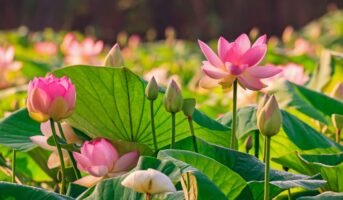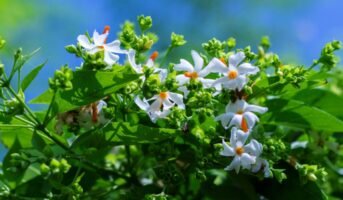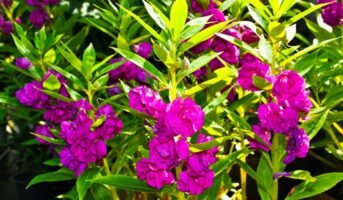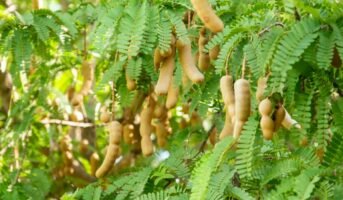If you’re looking to beautify your garden by adding a dash of colour to it, planting Hibiscus Syriacus can prove to be a great idea. These beautiful and exotic plants are available in a variety of vibrant shades, making them the perfect addition for enhancing your garden’s visual appeal. Moreover, they are extremely easy to grow and maintain. So, read on to know more about the benefits and uses of Hibiscus Syriacus as well as the best way to grow and care for them.
What is Hibiscus Syriacus?
Hibiscus Syriacus is a hardy, late-flowering hibiscus that revitalises and colours the garden when other plants are beyond their prime. From late summer to mid-autumn, Hibiscus Syriacus produces huge, trumpet-shaped flowers in pink, white, or purple against a background of three-lobed, dark green leaves. The plant is commonly known by the name Rose of Sharon.
The Rose of Sharon, which is emblematic of beauty in the Bible and is used to depict the beauty of King Solomon’s lover in the Song of Solomon book, gives rise to the name Rose of Sharon. For Jews and Christians today, the Rose of Sharon represents love, beauty, and healing. Some people view the Rose of Sharon as a Christ sign.

Source: Pinterest
See also about: semal tree
Hibiscus Syriacus: Key facts
| Common name | Rose of Sharon, shrub althea, Rosemallow, Syrian mallow, Syrian hibiscus |
| Botanical name | Hibiscus Syriacus |
| Family | Malvaceae |
| Plant type | Shrub |
| Mature size | 8–12 ft. tall, 6–10 ft. wide |
| Bloom time | Summer, fall |
| Flower colour | Pink, purple, lavender, red, blue, and white. |
Hibiscus Syriacus: Types
There are numerous varieties of Hibiscus Syriacus available. The common ones include:
- Blue Chiffon: From mid-summer to autumn, this cultivar produces double flowers (two layers of petals) with a purple-blue tint. It spreads out to a maximum height of eight to twelve feet.
- White Chiffon: The flowers of this type of Hibiscus Syriacus are completely white and lack a contrasting throat. It reaches heights of six to eight feet and widths of four to six feet.
- Red Heart: The ruffled, white petals of this shrub’s flowers have dark red cores.
Hibiscus Syriacus: How to grow it?
It’s remarkably easy to grow Hibiscus Syriacus. Here’s what you need to do if you want to plant it in your home garden.
- Hibiscus Syriacus is easy to grow in full sun to partial shade, with average, medium moisture and well-drained soils. In full sun, blossoming is at its best.
- Hibiscus Syriacus prefers moist, organically rich soils but may survive some drought and poor soils. It’s extremely resilient to summertime heat and humidity.
- Hibiscus Syriacus is generally tolerant of city life.
- Late winter pruning back to two or three buds may result in greater blooms.
- The plant can easily multiply through stem cuttings. Hibiscus Syriacus has the ability to aggressively self-seed in the best growing conditions.
Hibiscus Syriacus: How to care for it?
Every year, in the spring, feed the Rose of Sharon with a slow-release, high-potash composition, such as Rose Food. Mulch in the fall to prevent weed growth and assist in preserving soil moisture levels. Remember that Hibiscus Syriacus goes into leaf in late spring or early summer like all hardy hibiscus; wait until July before giving up on it.
Rose of Sharon doesn’t need to be deadheaded. Start pruning your Hibiscus Syriacus once a year after three years, or after it has grown to around 1.5 metres in height. The weight of the leaves might cause the outer branches to tumble outward if they are not clipped.
Hibiscus Syriacus: Sunlight requirements
Full sun, or at least six to eight hours of direct sunlight most days, is what Rose of Sharon prefers. However, Hibiscus Syriacus can also thrive in some shade. However, excessive shadow can reduce flowering and promote illnesses like fungus.
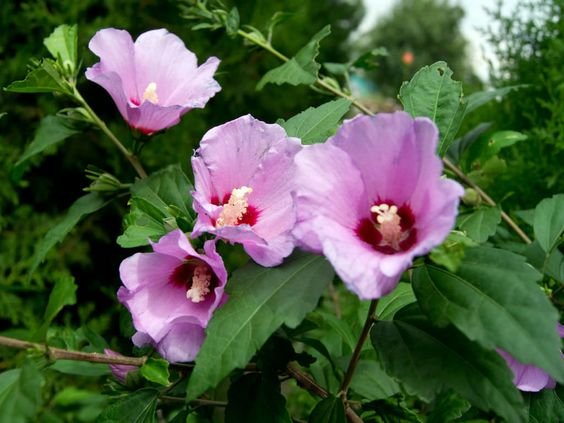
Source: Pinterest
Hibiscus Syriacus: Soil requirements
Various soil types, including loamy, sandy, and clay soils, are suitable for this shrub’s growth. Hibiscus Syriacus can handle slightly alkaline soil but prefers one that is nutrient-rich, well-draining, and between slightly acidic and neutral in pH.
Hibiscus Syriacus: Water requirements
Although mature Hibiscus Syriacus may withstand some drought, it grows best in damp soil. Extreme dryness or wetness will not support its growth.
Hibiscus Syriacus: Humidity and temperature requirements
Even though Hibiscus Syriacus enjoy the heat, they can also endure winters with below-freezing temperatures of up to -20 degrees Fahrenheit. If the air is circulated properly, it can even withstand excessive humidity. In contrast, moist environments can encourage the growth of fungi.
What are the benefits of Hibiscus Syriacus?
Hibiscus Syriacus have many medicinal benefits. These include:
- The leaves of Hibiscus Syriacus have diuretic, expectorant, and stomachic properties.
- Hibiscus Syriacus is also used to treat itch and other skin diseases, dizziness, and bloody stools with a lot of gas. Mucilage, carotenoids, sesquiterpenes, and anthocyanidins are among the medicinal constituents found in the bark.
- The root bark decoction is antiphlogistic, demulcent, emollient, febrifuge, haemostatic, and vermifuge. It treats diarrhoea, dysentery, abdominal pain, leucorrhoea, dysmenorrhoea, and dermatophytosis.
Hibiscus Syriacus: Is it an indoor plant?
Although they may be grown inside your homes in containers, the miniature Rose of Sharon requires sufficient air circulation and bright sunlight to thrive. Therefore, moving Hibiscus Syriacus outside in your garden during the warmer seasons is advisable.
Hibiscus Syriacus: Tips and tricks
Following are some tips to keep in mind when it comes to growing and maintaining Hibiscus Syriacus:
- Hibiscus Syriacus are excellent foundation plants. Plant them close to buildings to provide cold protection.
- The colours of Hibiscus Syriacus can be very vibrant. When designing your garden’s landscape, be careful to avoid using clashing shades together.
- They are not good for cut flowers as the bloom only lasts for a couple of days. Use dried seed pods for a long-lasting arrangement and exotic look.
- Hibiscus Syriacus are multi-trunked shrubs, which can be trained as espaliers or single-trunk small trees.
FAQs
Is Rose of Sharon simple to maintain?
How quickly can the Rose of Sharon grow?
Rose of Sharon grows at a moderate rate, adding one to two feet yearly.
Is the Rose of Sharon toxic?
Housing News Desk is the news desk of leading online real estate portal, Housing.com. Housing News Desk focuses on a variety of topics such as real estate laws, taxes, current news, property trends, home loans, rentals, décor, green homes, home improvement, etc. The main objective of the news desk, is to cover the real estate sector from the perspective of providing information that is useful to the end-user.
Facebook: https://www.facebook.com/housing.com/
Twitter: https://twitter.com/Housing
Email: [email protected]


